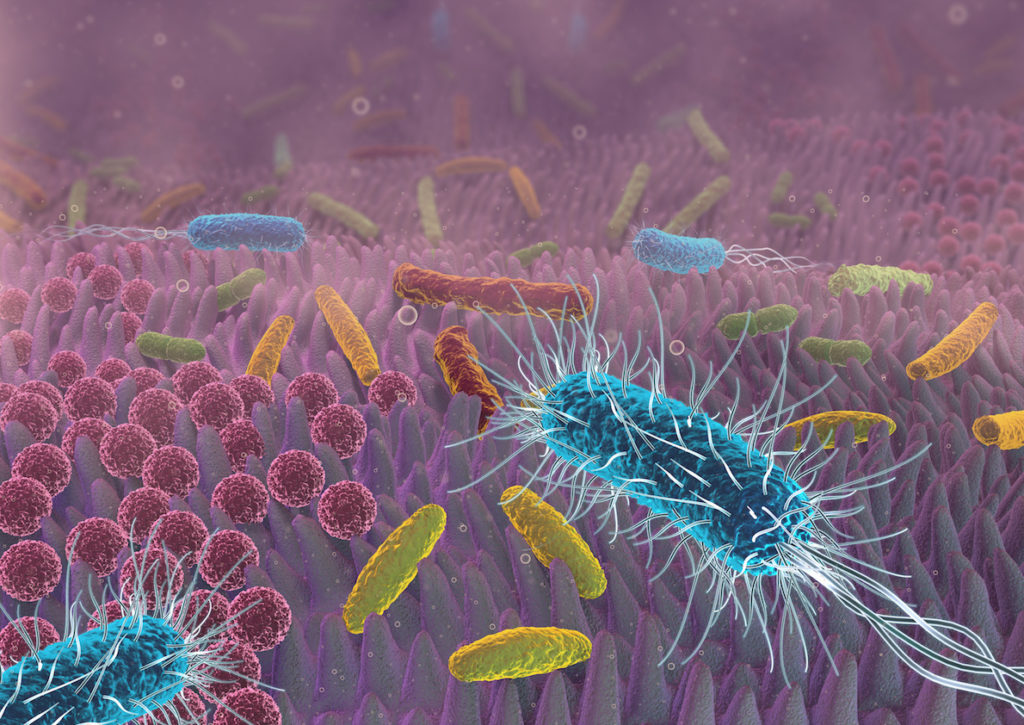
These intestinal bacteria to prevent Salmonella infections
Gastro-intestinal infections as a result of consumption of contaminated food is a relatively common complaint. Not rare are the trigger of the infection is Salmonella, but not every person who picks up the pathogen, the disease. The crucial difference in the intestinal flora of the Affected power here. A research team from the Ludwig-Maximilians-University (LMU) were able to identify in a recent study, gut bacteria, the Salmonella infection.
What is the bacteria in the gut flora the protective effects against Salmonella infection was largely unknown up to now, explained the research team of Prof. Bärbel Stecher Max von Pettenkofer-Institute of the LMU, the starting point of the current study. In animal studies on mice, could the researchers identify a bacterium, “in the mouse model against infection with Salmonella enterica serovar Typhimurium – one of the two in Germany, the most common subspecies – protects”, is reported by the LMU. The results of the study were Cell in the journal “Host & Microbe“ was published.

Risk groups for severe infections
Contamination with Salmonella in food-certainly not a rarity, and the rod-shaped bacteria severe gastro-intestinal disorders can be in the Form of the so-called salmonellosis. More than 16,000 of such diseases, for example, were reported in the year 2014 in Germany, the Robert Koch Institute. Most frequently children in the age under ten years of age, especially small children were affected. Especially in the case of “members of risk groups such as infants, small children, elderly or immune-compromised people can pass a Salmonella infection is difficult,” warn the researchers of the LMU.
Healthy intestinal microflora provides protection against infection
For people with an intact intestinal microflora is the causative agent there, but usually not dangerous. So only about ten to 20 percent of those who take in the germs, at all infection suffered. The natural intestinal flora can protect “against infection with Salmonella, particularly because of the commensal bacteria produce inhibitors, all fill niches and relevant nutrients such as sugars or proteins, but also consume oxygen,” explain the researchers. How a healthy intestinal microflora must be composed of, in order to protect against infections, the researchers Sandrine Brugiroux and Debora Garzetti in the first step of the study on the basis of a comparison of the Multiple of various mouse groups studied.
Bacteria the protective effect?
The animals divided in two groups: compared To Salmonella infections protected mice and not from infection protected mice. The analysis of the intestinal bacteria in both groups showed that the protected mice, bacteria of the type Mucispirillum schaedleri occurred, which were absent in the other group. The bacterium “is part of a bacterial large-group, whose representatives live mainly in mud or sediment – only Mucispirillum is found in the intestines of warm-blooded animals, in mice, like people,” reports the LMU.
The study’s leader, Prof. engraver that was previously on the assumption that the bacterium Mucispirillum schaedleri does not occur in people so often. But this was evidently a miscalculation. Because “in the case of stool tests M. schaedleri is not often discovered, as these bacteria accumulate in the mucous layer of the intestine and in studies in which the intestinal mucosa was examined, they found the bacteria in 50 per cent of the subjects,” says the Professor of the LMU.
Causal relationship to the infection protection demonstrated
The protective effect of the bacteria examined in greater detail, Simone Herp used by the Max von Pettenkofer-Institute in the next step, a so-called gnotobiotisches model. This was mice, their intestinal first germ was free and then specifically was settled, so they carried out a well-defined intestinal flora. Generated by the research team, a group of mice with Mucispirillum in the gut, and another without these bacteria. “Both groups, we have infected experimentally with Salmonella and were able to actually show that Mucispirillum is causal with a protection against Salmonella infection,” says Prof. engraver.
Virulence factor of Salmonella is blocked
In further studies, the researchers were able to prove, “that the protective effect of Mucispirillum is based on the fact that the bacteria compete with the Salmonella specific nutrients, for example nitrate,” says LMU in a press release of the study results. Although this competition arrester is not necessarily the growth of Salmonella, but you can’t make your most important virulence factor. The virulence factor is the property on which the pathogenic effect is based – in this case, a so-called type-III-secretion system. This acts as a kind of a molecular needle, with the help of the Salmonella toxins injection in the epithelial cells. The only way the pathogen can penetrate into the epithelial cells, and ultimately inflammation and Gastroenteritis cause.
New ways of prevention?
The research team led by Professor Stecher, according to the current results could lead in the long term, possibly for the development of new methods of Prevention, but until then, much research is still needed. For example, to remain so far unclear whether the bacterium M. schaedleri also has negative effects in the gut. With the current work, the researchers have, however, made a significant contribution to the understanding of the protective effect of a healthy intestinal microflora against Salmonella infections. (fp)